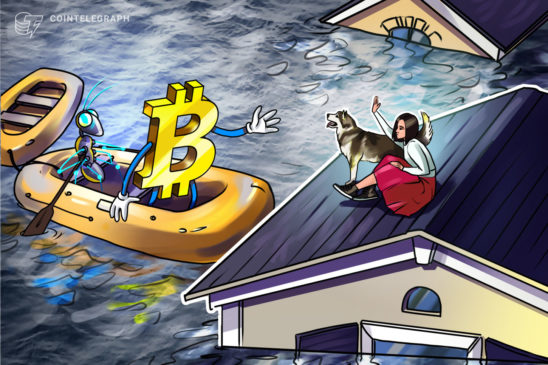Hurricanes and typhoons, earthquakes, cyberattacks and solar flares: There are many disasters, both natural and human-made, that have the potential to disrupt our digital-centric societies. With an estimated 4.5 billion people using the internet, many communicate with cell phones and email, while financially transacting using credit cards, apps and ATMs. But each of these critical services is dependent on a reliable connection to the internet and a continuous source of electricity — both of which are typically unavailable after a disaster.
As the planet continues to warm due to human-caused climate change, the risk to infrastructure only continues to grow. Rising sea levels will lead to increased coastal flooding that will put more energy generation facilities at risk, and as the globe’s food and water supplies are disrupted by changing weather patterns, international conflict may bring consequences yet unforeseen.
Luckily, after a catastrophic disaster, it is still technologically possible to both communicate with friends and family and take advantage of Bitcoin’s (BTC) resilient global financial network. In fact, even if the global internet network is no longer available, it is still possible to stay connected. The solution lies in decentralized and distributed local networks known as mesh networks, which could serve as the technological backbone of a disaster-ravaged future.
What do mesh networks do?
A mesh network is a decentralized and distributed local network, often powered using WiFi or Bluetooth connections, in which all the “nodes” on the network connect to each other directly. Each node connects to all other nodes within range, allowing for data to “hop” from node to node, shared with everyone connected to the mesh.
Nodes can also serve as access points to the network, meaning that if a node is set up with a WiFi access point, people can connect to the mesh using any device that is WiFi-capable. If individual nodes are solar-powered, a mesh network can theoretically operate for an indefinite period of time.
Such networks present a number of benefits during disasters, allowing people to communicate locally. If just one node has access to the global internet, it can share that access with all other users of the network. As Greta Byrum, director of the Digital Equity Laboratory at the New School and co-director of Community Tech NY — a group that works to educate communities on mesh networking — told Cointelegraph:
“If you lose connection to the internet, you can still share information around in the local area among the network nodes. You do need to have a server that is able to host the data, and then you can route it around your local network.”
Mesh networks prove their value
In October 2012, Hurricane Sandy swept through New York City, leaving behind an estimated $19 billion in damages and lost economic activity in its wake. The Brooklyn neighborhood of Red Hook saw widespread power outages and flooding after the storm, taking many people offline. The nonprofit Red Hook Initiative still had electricity and was able to keep a free WiFi hotspot up and running.
Soon, up to 300 people per day were accessing the RedHookWiFi network to connect and communicate, with volunteers expanding the network by adding additional routers and software to the mesh, such as an app that let users text their location and needs, which were then automatically plotted on a map.
Now, the RedHookWiFi project consists of a 35-node mesh WiFi network, with local businesses, residences and community organizations all pitching in to provide real estate for its routers. Five of the nodes are solar-powered, and the network’s servers have been backed up in a physical location outside of the neighborhood as well as in the cloud, according to Steve Amarante, a partner at Sky-Packets — the IT company that helps to maintain the network. He added that as the network continues to grow, “future plans call for additional power resiliency in the form of battery cells and additional data redundancy.”
In the short term, the goal of the project is to bring free WiFi into a nearby public housing project to increase residents’ personal resiliency, according to Javier Lopez, chief strategy officer of the Red Hook Initiative. He told Cointelegraph that in the event of another catastrophic disaster, “We aim to keep the network running and hosting various messages and updates during its log on splash page. Once logged on they will be [able to] go to school, work, play, connect to family (just like any normal connection).”
The do-it-yourself approach
But what if there are no resources for enterprise-grade servers, or what if a commercially installed network is destroyed? Luckily, mesh networks can be assembled together in a do-it-yourself fashion and deployed anywhere to create an entirely off-grid communications network.
All one needs to get started is a WiFi router, a small computer such as a Raspberry Pi to act as a server, some cables, a battery and solar charger — according to New America, a Washington, D.C.-based think tank that was active in helping New York City to construct mesh networks in multiple coastal neighborhoods following the hurricane. In a zine developed to teach people how to assemble DIY mesh WiFi hotspots, the think tank describes the benefits of such technology, for example stating that: “A local network can serve as a ‘micro-internet’ in some of these scenarios.”
Byrum, who previously directed New America’s Resilient Communities program that released the zine, told Cointelegraph that such DIY networks are currently being used in COVID-19 pandemic recovery efforts. In rural Tennessee, residents without internet access are able to receive telehealth services from a clinic that has suspended in-person visits, and in Kingston, New York, a pop-up COVID-19 testing center is being powered by an old news broadcasting van with a built-in local network access point. “The whole thing is solar-powered,” Byrum said, adding: “It’s a mobile solar-powered WiFi van that has a 40-foot arm to stick the WiFi antenna up.”
Spending decentralized currency
Historically, cash has been king in a disaster, but as society moves into an increasingly digital world, this may not stay the case. If electricity is knocked out in a disaster, so too are credit card readers, digital payment terminals and ATMs. Once the backup batteries of cell towers die, cell phones will turn into mere flashlights and clocks. Even when there is no disaster, payment systems can crash, like in June 2018 when Visa’s global payment network went down in Europe.
Meanwhile, cryptocurrencies such as Bitcoin offer highly resilient financial networks, as they are globally distributed and thus less vulnerable to disruptions. There is no centralized facility or server that can fail and bring the entire network down. As such, the Bitcoin network has been operational for 99.99% of its existence since inception. However, even if the network is up and running, without the internet, transactions cannot be added to the blockchain, which effectively means that crypto can not be used.
Thankfully, the same mesh networks can also power on-chain transactions. As previously stated, one of the major benefits of a mesh network is that just one node needs access to the internet for all nodes to share in that access.
Related: Offline Transactions: The Final Frontier for Global Crypto Adoption
The developer known as “Grubles” demonstrated in January 2019 how one can broadcast a transaction through a mesh network to be added to the blockchain. The developer set up a Bitcoin full node connected to a satellite receiver that obtained blockchain data via the Blockstream satellite network. They then used an Electrum Wallet, the TxTenna app developed by decentralized communication tech company GoTenna, and a GoTenna Mesh device to send it through a mesh network until it was able to be broadcast. Once it was added to the blockchain, Grubles verified the transaction through the data downloaded from his so-called “satnode.”
Another developer by the name of “Nixops” claimed in September 2018 to have completed an off-grid “proof-of-life” transaction on the Burst blockchain by using a mesh network to send data packets via amateur radio bands. More recently, Venezuela-based startup Locha Mesh announced that it is developing off-grid hardware devices that will connect to a phone or laptop to broadcast crypto transaction information over a mesh network strung together using ultra high-frequency radio waves. Once the transaction hops to a device connected to the internet, the data is broadcasted and added to the blockchain.
Powering internetless crypto economies?
Within any one person’s lifetime, the chances of being subject to a disaster catastrophic enough to wipe out the power grid, global terrestrial internet and satellite network are extremely slim. However, a huge solar storm is one disaster that might be worth staying up at night to worry about. Such an event is statistically inevitable and has already occurred once — possibly twice — within the past 150-odd years. In fact, Earth saw a near miss of such a storm in 2012.
So, in a world in which any sort of global network is no longer possible to maintain, is there any hope for rebuilding a digital economy? The answer is: Yes — mesh networks could theoretically provide the backbone for an internetless, regional, crypto-based community. But in reality, it’s not so simple. According to Byrum, any service that uses the global internet can, theoretically, be replicated on a local network — albeit in a more limited capacity. “It’s really different to be in a chat room with your neighbors just talking about food and water,” she said, “That’s a really different experience than, ‘I’ve got memes and GIFs.’”
Rieki Cordon, a facilitator for Seeds — a crypto platform that seeks to build the foundation for sustainable communities — told Cointelegraph that operating a local blockchain would be possible and might provide some value for logging economic activity, but in such an event, utilizing blockchain would be the last thing on anyone’s mind. Neighborhoods can embrace blockchain and crypto now, before a disaster occurs, in order to build strong communities that are inherently more resilient, adding:
“Use this technology to generate new forms of wealth and use that to create circular economies and local food systems. Use decentralized governance so people can start learning how to make decisions and create together. […] Then if a catastrophic event shuts the technological system down, the community is more capable of handling it. The food they planted, the infrastructure for local need production and community bonds they created in the process will remain and ultimately prove more valuable than any blockchain or crypto-network.”
Prepare for the worst, hope for the best
While mesh networks and access to crypto can undoubtedly help to power neighborhoods during even the most catastrophic of disasters, one thing is clear: Technology is useless without people who know how to use it and communities that have already organized around it. Byrum told Cointelegraph that mesh networks “could absolutely be key to rebuilding, but it’s also the knowledge,” adding, “The equipment and the software/firmware — it doesn’t do you any good if you don’t have the skills.”
Indeed, preparedness is considered to be one of the four fundamental stages of a disaster’s life cycle. In a truly catastrophic disaster, it could take years to fully rebuild infrastructure, supply chains and the economy. For Cordon, the idea of building sustainable, crypto-based communities is directly connected with disaster preparedness, but the technology itself is not what’s important:
“We can use this technology to transition our civilization and address humanity’s greatest crises — every step we take in that direction helps us become more prepared for the crises to come.”




